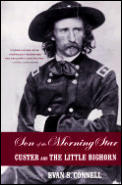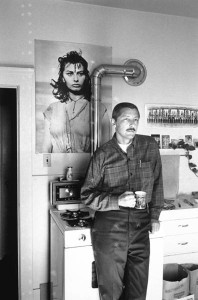 Son of the Morning Star is Evan S. Connell’s look at the life of George Armstrong Custer. We all know about the battle, but what about the man? To listen to Connell, if it weren’t for the time, place, and manner of his demise, the world would little note nor long remember this vain and impetuous martinet. Indeed, were his to biography focus solely on it’s titular subject, it would be a pretty thin book. The value of Connell’s work is that he places the now-vaunted cavalryman in context, with time, place, and people.
Son of the Morning Star is Evan S. Connell’s look at the life of George Armstrong Custer. We all know about the battle, but what about the man? To listen to Connell, if it weren’t for the time, place, and manner of his demise, the world would little note nor long remember this vain and impetuous martinet. Indeed, were his to biography focus solely on it’s titular subject, it would be a pretty thin book. The value of Connell’s work is that he places the now-vaunted cavalryman in context, with time, place, and people.
Oft-demoted, often court-martialed, Custer assumed command of a division in an army of leftovers. Post civil war, the country wanted the most they could get out of a military that had been largely dismantled. The cream of the crop stayed in the east, the rest went to the frontier. Granted, Sheridan had a command, as did Sherman. But, as soldiers go, Sherman was an old man by the time of these last Indian wars (1876 was the date of the Little Bighorn.), and Sheridan was an exception. Among the enlisted, desertions were rife due to lousy pay, terrible food, capricious discipline (of which Custer was a master), and–most of all–sheer boredom. Among the officers, drunkenness was rife, physical disabilities–half-blindness, missing limbs, arthritis–were commonplace, and incompetence proliferated. Two key battles leading up to the grand conflict were lost due to officers’ incompetence and disobedience.

Combine those conditions with the appearance on the scene of some of the most astute and savage warrior-generals in Native American history–Red Cloud, Sitting Bull, Crazy Horse, and Gall–and you have a perfect recipe for defeat on the basis of personnel alone. In addition, the Indians were truly down to their last out. White settlement had narrowed their land to a strip of Wyoming and the Dakotas in the east and north and the Black Hills on the west. With the discovery of gold in the Black Hills, their last sanctuary was threatened. They had nowhere left to go.
Connell narrates the events leading up to these conditions just as one might expect. However, he does not do it in a straight line. His storytelling is, I suppose you might say, peripatetic. Elliptical. He’ll start telling the story of one of the Indians involved in the battle, then will give the history of his family, of how he got his name, of what he thought of Custer or the battle twenty years or so later, then will finally return to the battle itself. The result is sometimes frustrating. You want to get on with the chase. Then you realize you already know about the chase. And you begin to realize how outsized the history of this battle and of Custer himself is compared to the story of White-Indian conflict in the west. As outsized as the huge painting which has come to symbolize the massacre.
In truth, not only was Custer not famous among the Indians, few knew his name. If he was known, his long yellow curls were his identifier, but those were shorn for the battle. It was only after that battle, after the press and others began asking Indians who killed him that the Indians began to realize that he had suddenly gained some notoriety. Suddenly there were many takers for the honor.
The true significance of the man and the battle is summed up in the words of Kate Bighead, a Cheyenne woman, who knew Custer from before the battle and was present at the scene before, during, and after the fighting. “I have often wondered if, when I was riding among the dead where he was lying, my pony may have kicked dirt upon his body.”
